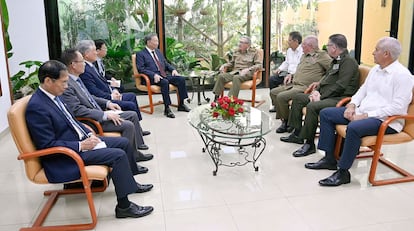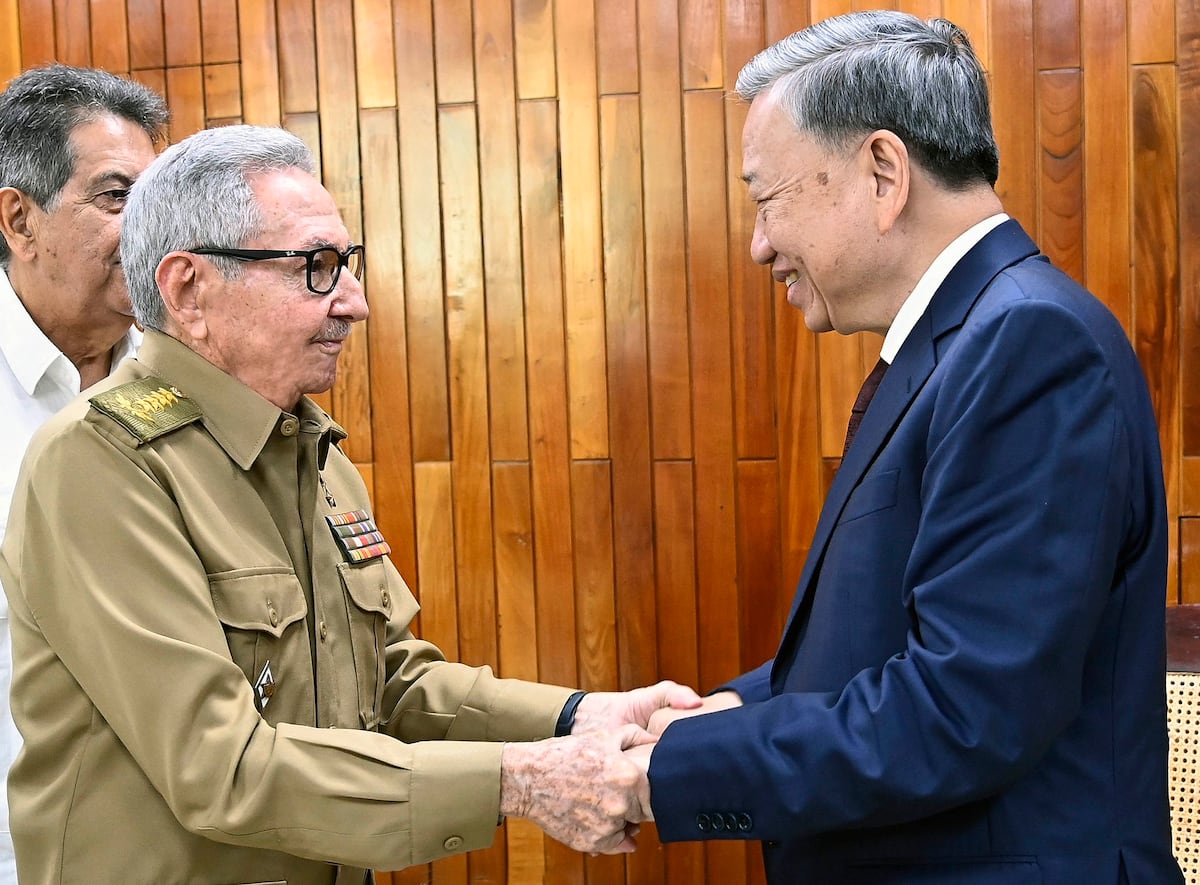Raúl Castro is still alive. This is what the government apparatus in Cuba wanted to make clear, which displayed him a few days ago amidst the constant rumors announcing his death. It had already seemed strange that Castro, accustomed to receiving ministers and senior leaders in Havana, was not present on the first day of the visit to the island by the president of Vietnam, To Lam, who was welcomed by the ruler, Miguel Díaz-Canel, and his wife. It would seem enough that the president could deal with this type of reception alone, but the truth is that the figure and the surname Castro continue to pull the strings, at least symbolically, of Cuban diplomacy and power in the country.
Not having seen Castro amid the formalities of To Lam’s visit, many Cubans began to wonder what had happened to the former president, who unofficial sources have stated on several occasions is in a delicate state of health. More than once the networks have been populated in recent times with posts speculating about his death. Perhaps, as Cuban Lisbet Tase states, because “that is what ordinary Cubans most expect.”
After false news, it is the days of silence and no definitive fact that are responsible for dispelling the rumors. The Cuban Government has never appeared to openly rule out his death, or to confirm if it is true that he suffers from some type of illness, something that would not be a rarity at his 93 years of age, which he completed on June 3. It is nothing that the Executive has not already done: deep secrecy has always guarded the Cuban leaders, their lives, partners, and health conditions.
What the Government has done has been to bring Castro’s figure to the public when some news – until now all false – announces his death. The day after the visit of the Vietnamese president, the Cuban politician and military man appeared shaking his hand in a photo shared by the Cuban Presidency. The message was clear: Castro is still alive.
The strategy is not new either: when the death of Fidel Castro was imminent, and more than once news of his death was spread, the Government denied them all with some public appearance. The day his death became true, no one predicted it. It was his own brother who took the microphone and very solemnly announced that Fidel had died at the age of 90.

The last appearance of the youngest of the Castro brothers was only a few days ago, when the images of the funeral of General and First Vice Minister of the Army Corps Ramón Espinosa Martín were televised. Raúl, with a reduced stature, his lips almost swallowed, his olive green uniform corseted and stiff, reappeared along with some of those who are part of the power dome amidst flower crowns and the required and martial parades as a farewell.
For some time now, Castro has had to say goodbye to several of the historical leaders of the Revolution. The cycle of history seems to be closing, the end of an era: more than sixty years ago that generation began to occupy positions of power in the country with the nascent Revolution and now, when we talk about the worst crisis in the history of Cuba , time forces them to abandon their positions. In September, five people related to high places died, all over 80 years old, which shows that relief in Cuba only comes by natural force. In addition to Espinosa Martín (85), Raúl fired at least five more leaders, almost contemporaries: Romárico Vidal Sotomayor García, Juan Antonio Hernández Hernández, Jorge Luis Guerrero Almaguer, Juan Israel Cervantes Tablada and Leonardo Ramón Andollo Valdés. In the longest-running government in the Western Hemisphere, Ramiro Valdés Menéndez, 92, still holds positions; José Ramón Machado Ventura, 93, or Guillermo García Frías, 96.
Other times, the Cuban Government does not bring Raúl’s figure to light to deny an alleged death, but rather to give the support that Díaz-Canel, an uncharismatic leader, who has been in a time of economic crisis, constantly needs. coronavirus pandemic, drop in tourism, natural disasters, massive and unprecedented protests and the largest migratory exodus in the country’s history. When Cubans took to the streets like never before on July 11, 2021, Castro, without positions in the Government – in 2018 he left that of president of the Council of State and Ministers of the Republic of Cuba and in 2021 that of first secretary of the Communist Party – attended a public celebration and the closing of an event of the Party’s Central Committee. As if not to forget the traditions, which have recently fallen into disrepair among many Cubans, in January Raúl paraded alongside other top leaders in the customary Torch March event. Also at the beginning of the year, in the midst of the economic debacle and decision-making to channel the crisis in the country, Castro appeared asking leaders who “are not up to the task demanded by the moment” to resign from their positions. Castro has been in the news at the polls during elections, as a message to those in Cuba who have given up on the democratic exercise of voting. When Nicolás Maduro proclaimed himself Venezuelan president in July despite well-founded suspicions of fraud, it was Raúl Castro who made a complicit call to Caracas to congratulate him.
In all these appearances he has wanted to be shown as an active figure, aware of internal and external politics, and above all, he has tried to reaffirm the message that Castroism has not died, that it did not die with Fidel and that it did not even would die if the last Castro does it.
